SPECIAL REPORT: Who wins skirt & blouse votes in 2020?
In the 2016 elections, Ahmed Alhassan went to the polls with a dilemma. He loved two candidates–the presidential candidate of his party and the community activist who stood as a parliamentary candidate on a rival party’s ticket.
He had always voted for his party’s presidential and parliamentary candidates together, but for once, his loyalty was being tested. He had to split the votes.
In the end, he settled on the presidential candidate of his party and the parliamentary candidate of the rival party.
What is skirt and blouse?
His decision is known in Ghanaian political lexicon as ‘skirt and blouse voting’ –a phenomenon where a voter chooses to vote for different candidates in the presidential and parliamentary elections.
It became part of the country’s political culture since 1996.
There is no data for the 1992 election to compare the performance of the two parties in 1992 since the NPP boycotted the 1992 parliamentary election over allegations of rigged presidential election—a reason which compelled the Electoral Commission (EC) to introduce reforms that mandated both presidential and parliamentary elections to be held on the same day.
Theghanareport.com’s data analysis from 1996 indicates that skirt and blouse voting favour National Democratic Congress (NDC) presidential candidates than their parliamentary candidates.
2012 vs 2016
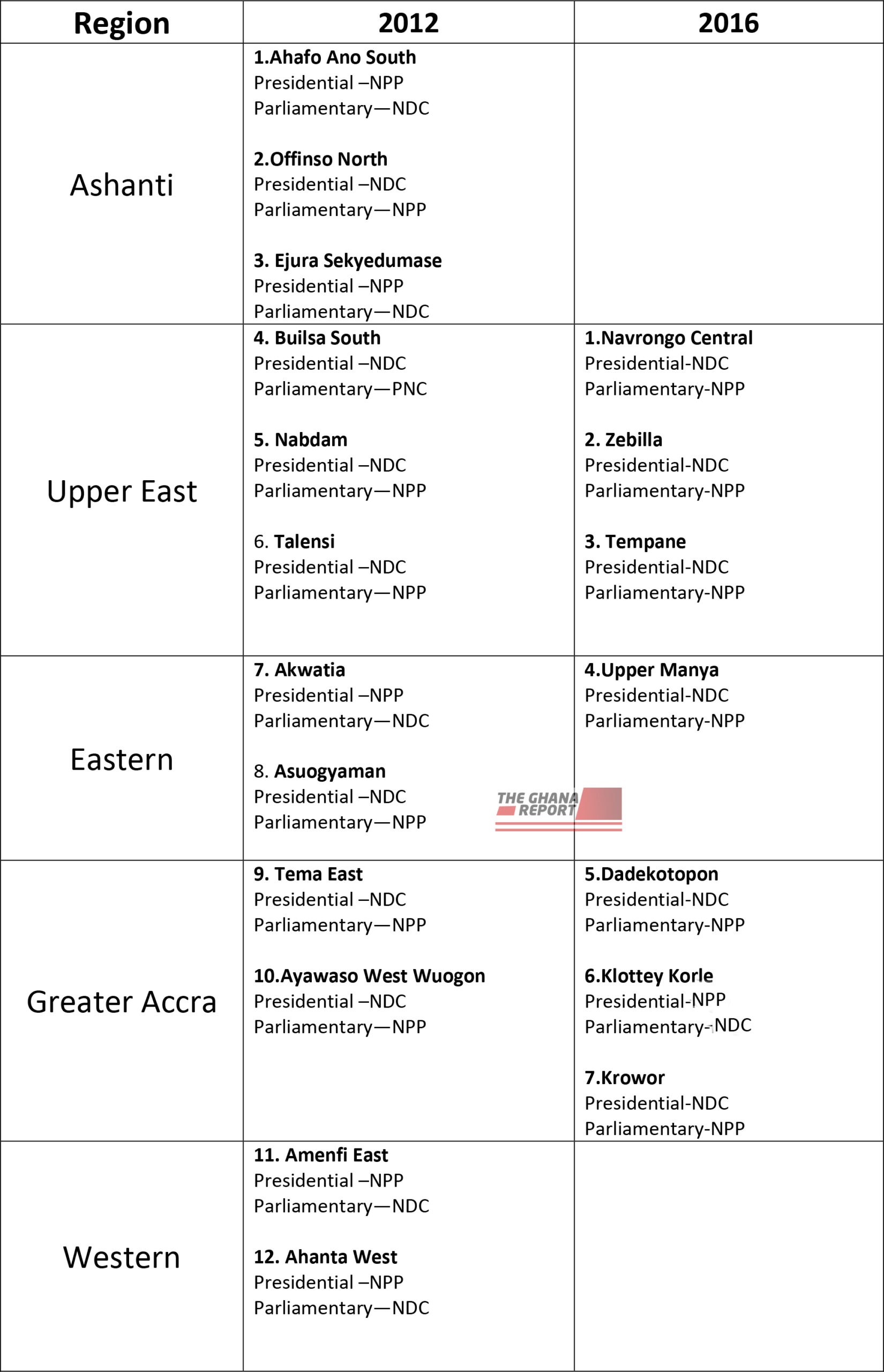
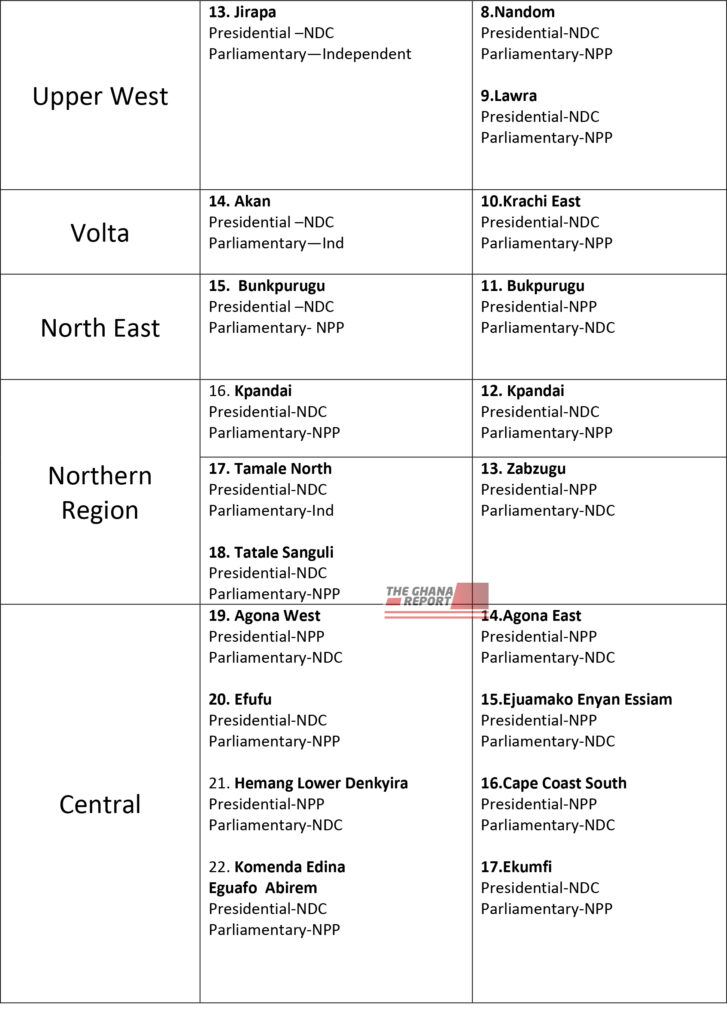
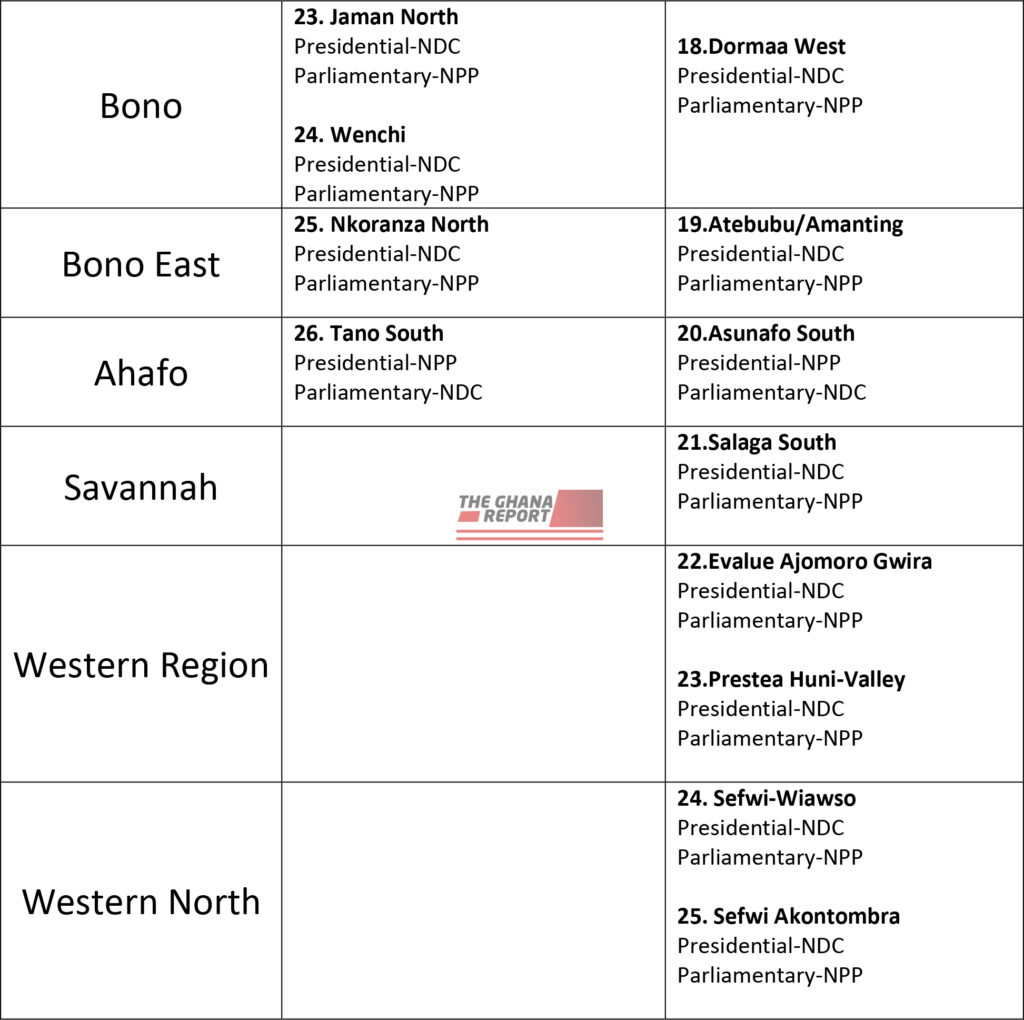
Only two out of the 26 constituencies that voted ‘skirt and blouse’ in the 2012 election repeated the practice in 2016.
The National Democratic Congress Presidential candidates fare better with ‘skirt and blouse’ voters.
On the flip side, New Patriotic Party (NPP) parliamentary candidates performed better than their NDC counterparts in skirt and blouse votes.
Mahama won 22 out of the 28 constituencies that voted skirt and blouse in 2016. Nana Akufo-Addo won six. But that also means NPP candidates won in 22 out of the 28 constituencies.
Electoral records from 1996 to 2016
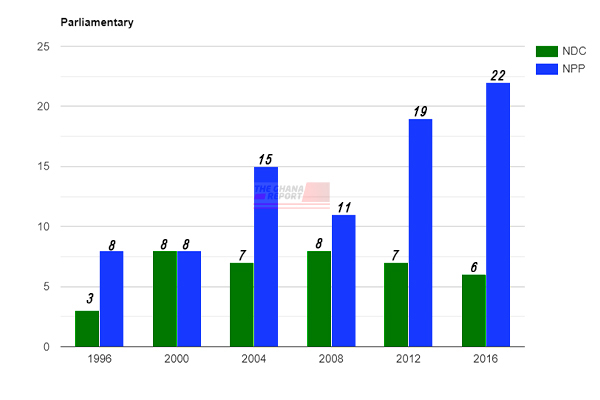
In 1996, 11 constituencies voted skirt and blouse; In 2000, it increased to 17. In Kufuor’s term in 2004, 22 constituencies decided not to stick to one party in the presidential and parliamentary elections.
When Akufo-Addo and Mills met in 2008, 19 constituencies went skirt and blouse, the number shot up to 26 when Mahama met Akufo-Addo in 2012. When the two met again in 2016, Mahama picked 22 out of the 28 skirt and blouse constituencies.
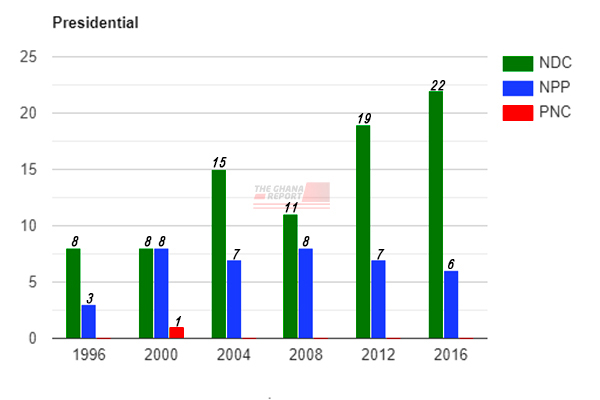
Apart from 2008, in every election year since 1996, the number of constituencies that opted for skirt and blouse voters has been going up.
In the 2012 election, out of the 26 constituencies that voted skirt and blouse, President Mahama won 19, while the New Patriotic Party (NPP) presidential candidate won seven.
However, only 12 out of the 19 constituencies that voted ‘skirt and blouse’ for President Mahama in 2012 endorsed him again in 2016. The remaining 14 constituencies shifted to President Nana Akufo-Addo.
Notable constituencies that are NPP strongholds but voted for the National Democratic Congress (NDC) presidential candidate in 2012 and chose the NPP parliamentarians include Ayawaso West Wuogon and Tema East in the Greater Accra Region; Nkoranza North (Bono East) and Wenchi, the home constituency of Dr Kofi A. Busia—a stalwart of the NPP—in the Bono Region and Offinso North in the Ashanti Region.
However, all those constituencies reverted to the NPP Presidential candidate in the 2016 elections.
The NPP candidate also won NDC strongholds—Agona East, Ajuma Eyan Essian, Ekumfi and Krowor.
The unique constituency
The trend showed that the Agona East constituency is the only constituency in Ghana that gives every president a full 8- years in office.
After that, it votes in the opposition. And every time the constituency votes after 8 years, the main opposition presidential candidate wins.
It has consistently voted ‘skirt and blouse’ for the presidential candidate of the main opposition every eight years and in all instances, the opposition party won the election.
It did for ex-President John Agyekum Kufuor in 2000; late President John Evans Atta Mills in 2008 and Nana Akufo-Addo in 2016.
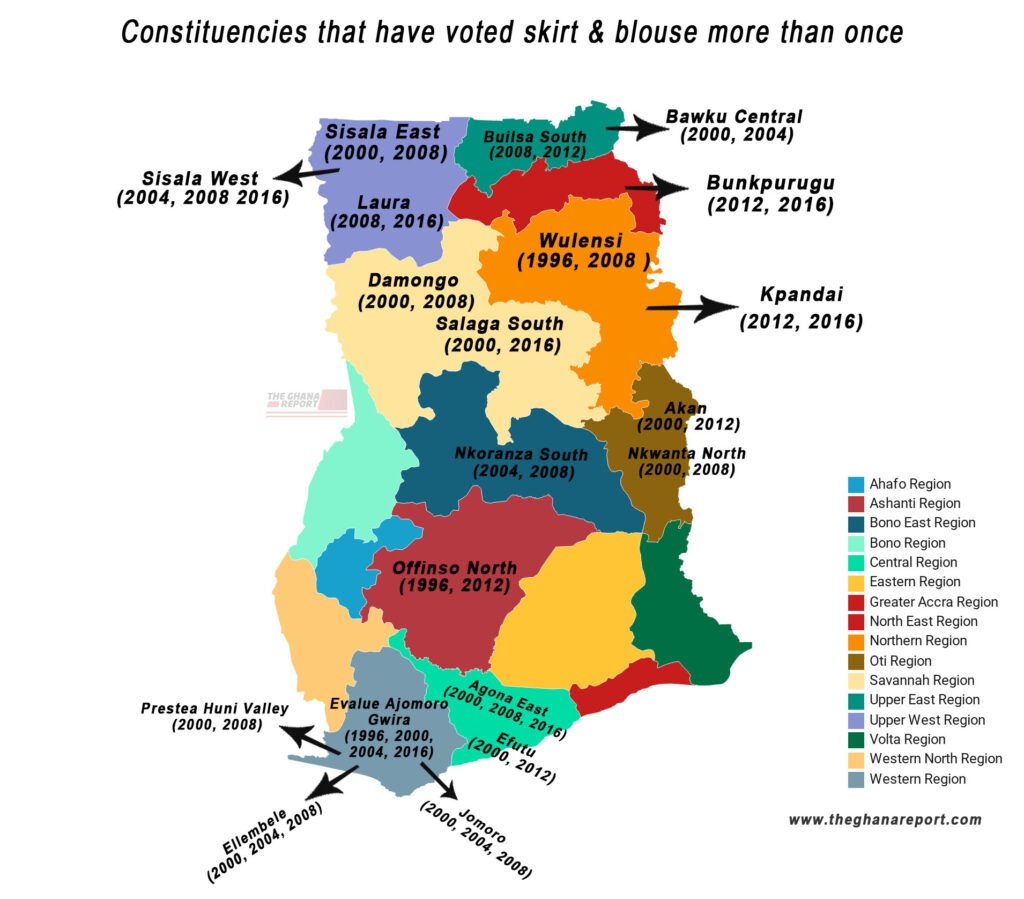
1992
There is no data for the 1992 election to compare the performance of the two parties in 1992 since the NPP boycotted the 1992 parliamentary election over allegations of rigged presidential election—a reason that compelled the Electoral Commission (EC) to introduce reforms that mandated both presidential and parliamentary elections to be held on the same day.
1996
According to the statistics, in 1996, only 11 constituencies in five regions—Ashanti, Brong Ahafo, Greater Accra, Northern and Western regions, voted skirt and blouse.
That year, eight constituencies—Offinso North, Tano North, Ablekuma South, Bimbilla, Wulensi, Ellembelle, Wenchi East and Tano North, voted for the NDC candidate—former President J.J. Rawlings, who was seeking a second term in office, leaving the remaining three—Evalue Ajomoro Gwira, Prestea Huni Valley and Mion for the NPP candidate who later won the 2000 election—former President J.A. Kufuor.
2000
In 2000, there was no skirt and blouse voting in the Ashanti and Upper West regions. But in all the other eight regions, the practice showed in 17 constituencies.
The NDC Presidential Candidate, Prof. J.E.A Mills, and the NPP Candidate, Mr J.A. Kufuor, had eight constituencies each voting for them in these skirt and blouse constituencies.
The People’s National Convention (PNC) presidential candidate, Edward Mahama, won the remaining slot in Bawku Central.
Interestingly, for the parliamentary results in Bawku Central, niether the NPP nor NDC won it. It was an independent candidate, the late Hawa Yakubu, who did.
She later joined the NPP and was once considered for the running mate position to Akufo-Addo.
NPP presidential candidate, John Agyekum Kuffuor eventually won the 2000 presidential elections after a run-off.
2004
In 2004, the Ashanti Region was the only region where no constituency voted skirt and blouse. But across the country, 22 constituencies did. The NDC presidential candidate, Prof. Mills, won 15 of them as against seven for the NPP flagbearer, John Kufuor.
In that 2004 elections, only four constituencies that votes skirt and blouse in 2000, repeated this voting pattern in 2004.
They are Salaga South, Bawku Central, Ellembelle and Evalue Ajomoro Gwira
Salaga South: Voted for the NDC,
Bolgatanga Central: Voters dropped the PNC flagbearer for the NDC in the presidential race and also dropped their independent MP, Hawa Yakubu after she stood on the NPP ticket. They voted for PNC parliamentary David Apasara to go to Parliament.
Ellembelle and Evalue Ajomoro Gwira constituencies: The voters kept faith with two CPP parliamentary candidates — Freddy Blay and Kojo Armah, as well as the NPP Presidential candidate, former President J.A. Kufuor.
2008
In 2008, 19 constituencies did skirt and blouse, 11 went in favour of the NDC presidential candidate as against eight for the NPP candidate.
Five constituencies which voted skirt and blouse in 2004 kept the pattern again in 2008.
They are Sisala East which went with the NPP in the presidential race and the NDC for Parliament.
Sisala West voted the NDC in the presidential contest but sent Mr Haruna Bayirga of the PNC to Parliament.
Nkwanta North in the Volta Region kept to its trend and voted for Prof. Mills of the NDC and the NPP’s Mr Joseph Nayan as Member of Parliament (MP).
However, for the first time in the skirt and blouse trend, Jomoro voted NDC in the presidential contest and the CPP’s Samia Nkrumah as MP.
2012
In 2012, 12 constituencies in three regions–Brong Ahafo, Central and Northern, voted skirt and blouse. In each of these three regions, four constituencies voted that way.
Ashanti and the Upper East regions: Three constituencies in each of these regions voted skirt and blouse.
Greater Accra, Eastern and Western regions: Two constituencies voted skirt and blouse.
Volta, Upper West regions: One constituency voted that way.
Out of the national total of 26 constituencies that voted ‘skirt and blouse’, only Builsa South had done the same thing in 2008— voting NDC for the presidency and the PNC for Parliament.
Strong parliamentary candidates
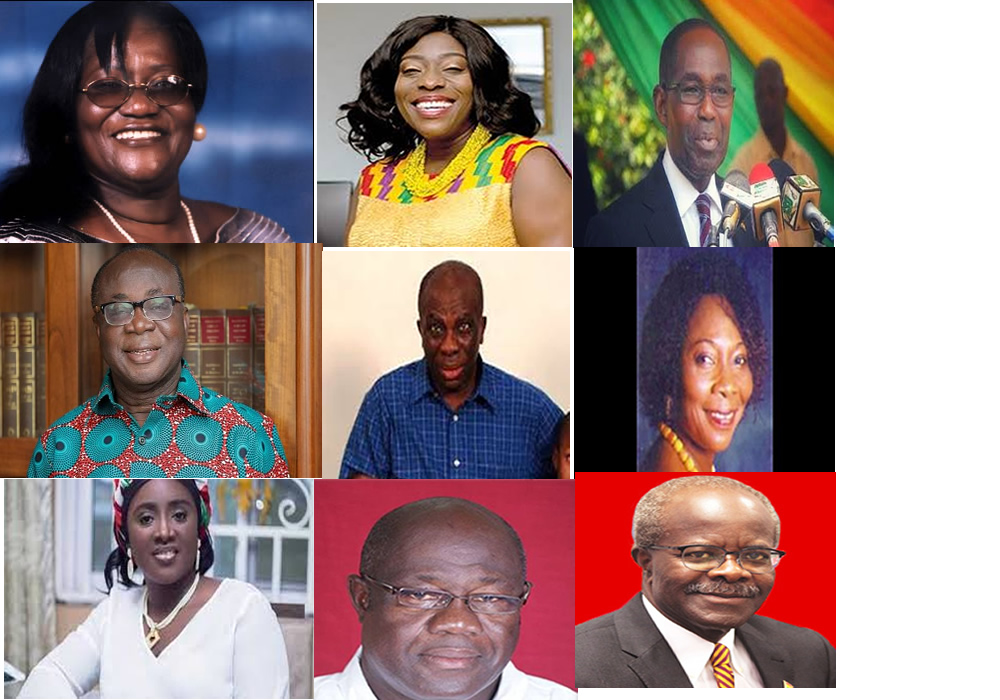
In constituencies that voted skirt – i.e voted for a different presidential candidate – it usually took strong parliamentary candidates to win the seat – the blouse.
For example, it took the likes of Ms Theresa Ameley Tagoe of the NPP (1996 & 2000) to hold the Ablekuma South seat even though the NDC won in the presidential results in that constituency.
Rawlings won the presidential results in Offinso North in 1996 but Dr. Kofi Konadu Apraku of the NPP won the seat.
Madam Edith Haizel of Evalue Ajomoro Gwira of the NDC won in 2000 but the NPP presidential candidate won there.
Mr Samuel Ofosu Ampofo of the NDC, Fanteakwa North in 2000; NDC’s Lee Ocran in Jomoro; Freddy Blay, then with the CPP (2000 and 2004), Dr Papa Kwesi Nduom (2004) who was then with the CPP, Hajia Alima Mahama (2004) in Nalerigu Gambaga.
These candidates won while their party’s presidential candidates lost.
Others include Mr Boniface Abubakar Saddique of the NPP (2004) in Salaga South; Lee Ocran of the NDC (2008) in Jomoro; NPP’s Agnes Chigabatia (2004) in Builsa North; Mr Ambrose Dery of the NPP (2008) in Lawra; Mr Fritz Baffour of the NDC (2008) in Ablekuma South; and Madam Hannah Bissiw of the NDC in Tano South (2012).
Mr Blay, Dr Nduom and Mr Kojo Armah, all candidates of the CPP in the past, benefitted from an alliance with the NPP in which the NPP did not field their candidates in constituencies that were seen as CPP strongholds.
This allowed the candidates to easily defeat the NDC there.
Only one constituency voted skirt and blouse in favour of a PNC presidential candidate—Bawku Central (2000 and 2004). The Mion Constituency in the Northern Region also voted the NPP for president and the CPP for parliament in 1996, electing CPP’s Mr Alabira Ibrahim as MP.
Volta Region skirt and blouse
The Volta Region records only one constituency voting skirt and blouse in every election since 2000.
The trend also showed that apart from 2000 when two independent candidates won Ambassador Victor Gbeho (Anlo) and Rashid Bawa (Akan), the electorate vote NDC and NPP and this switches among the Akan (2008), Nkwanta North (2004 and 2008) and Krachi East (2016) constituencies.
Why do people vote skirt and blouse
People have different reasons for which they vote skirt and blouse. For communication specialist, Joyce Sackitey, it was because “I liked the Parliamentary candidate and the presidential candidate, but they don’t belong to the same party.”
In the case of Evelyn Dogbatse, an entrepreneur, she would do so in the upcoming Volta Region records only one constituency voting skirt and blouse every election year since 2000.because she had no emotional attachment to any political party.



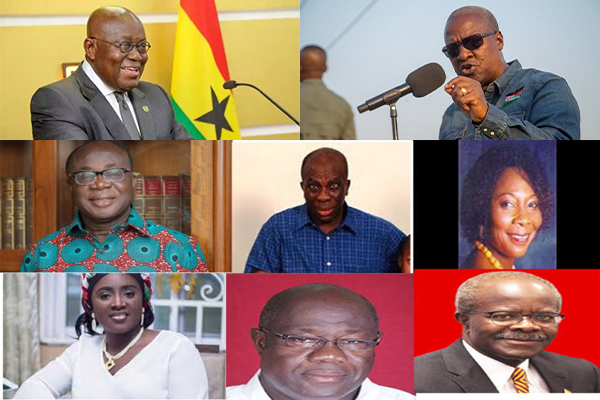
Klottey korle in 2016 voted for the NDC in both Presidential and Parliamentary . However, this piece is a good one.
I think chaina-Paga constituency is also one of the skirt and blouse constituency but is been left out.
It’s good to see our journalist adding statistical analysis to their reports. Very soon I will not be surprise to see ANOVA tables in our news.
Good job
This is a well disected write up